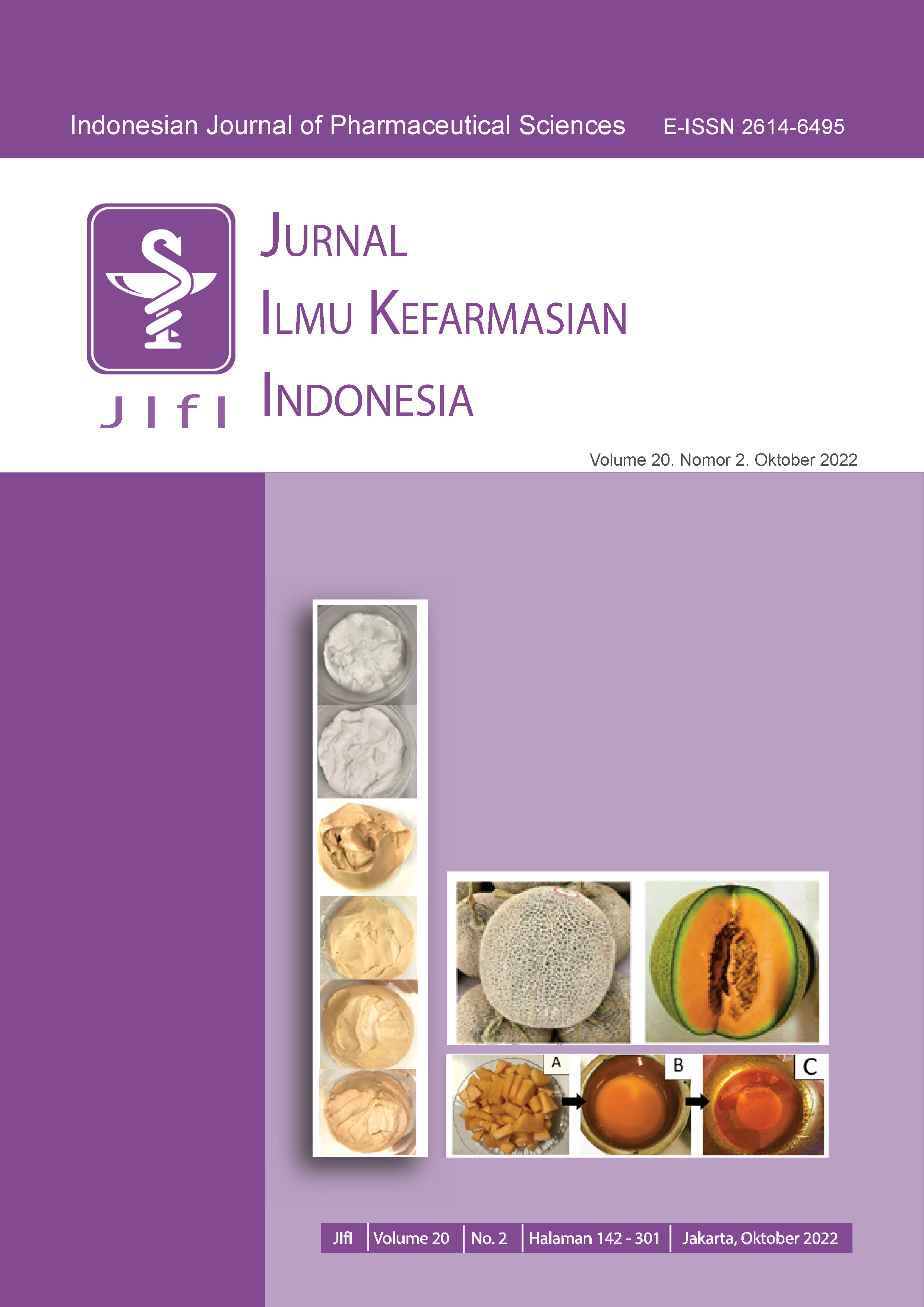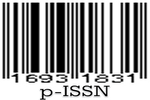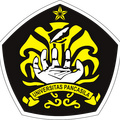In Vivo Incision Wound Healing Studies using Ethanolic Cinnamon’s (Cinnamomum burmannii) Leaves Extract in White Male Rats
Abstract
Cinnamon leaves are traditional plants that contain secondary metabolites such as flavonoids,
tannins, saponins, alkaloids, and phenols. All of these compounds play an essential role in the wound healing process. This study aimed to determine the effects of cinnamon (Cinnamomum burmannii) on incision wound healing in male rats. The research method used a post-test only control group design approach that uses five treatment groups: positive control (Bioplacenton® Gel), negative control (Vaseline flavum), and ethanol extract of cinnamon leaves at concentrations of 10%, 20%, and 30%. The results showed that the ethanol extract of cinnamon leaves affected wound healing, as observed from the day of wound healing, the AUC length of the wound, and levels of hydroxyproline. The statistical test results showed a significant difference between the groups (p<0.05), where the best concentration was 30%, followed by 20% and 10%. Therefore, we concluded that the ethanolic extract of cinnamon leaves can heal wounds in male rats.
References
2. Larouche J, Sheoran S, Maruyama K, Martino MM. Immune regulation of skin wound healing: mechanisms and novel therapeutic targets. Advances in wound care. 2018;7(7):209-31.
3. Yuan H, Ma Q, Ye L, Piao G. The traditional medicine and modern medicine from natural products. Molecules. 2016;21(5):559.
4. Juneja K, Mishra R, Chauhan S, Gupta S, Roy P, Sircar D. Metabolite profiling and wound-healing activity of Boerhavia diffusa leaf extracts using in vitro and in vivo models. Journal of traditional and Complementary Medicine. 2020;10(1):52-9.
5. Moeini A, Pedram P, Makvandi P, Malinconico M, d'Ayala GG. Wound healing and antimicrobial effect of active secondary metabolites in chitosan-basedwound dressings: A review. Carbohydrate polymers. 2020;233:115839.
6. Bapat UC , Mhapsekar DR. Phytochemical investigations and antimicrobial and anticancer
activities of Homonoia riparia lour. International Journal of Pharmacy and Pharmaceutical Sciences. 2014;6(11):237–43.
7. Aslam MS, Ahmad MS, Riaz H, Raza SA, Hussain S, Qureshi OS, Maria P, Hamzah Z, Javed O. Role of flavonoids as wound healing agent. Phytochemicalssource of antioxidants and role in disease prevention. 2018:95-102.
8. Carvalho MT, Araujo-Filho HG, Barreto AS, Quintans-Junior LJ, Quintans JS, Barreto RS. Wound healing properties of flavonoids: A systematic review highlighting the mechanisms of action. Phytomedicine. 2021;90:153636..
9. Su X, Liu X, Wang S, Li B, Pan T, Liu D, Wang F, Diao Y, Li K. Wound-healing promoting effect of total tannins from Entada phaseoloides (L.) Merr. in rats. Burns. 2017;43(4):830-8.
10. Ambreen M, Mirza SA. Evaluation of ant iinflammatory and wound healing potential of tannins isolated from leaf callus cultures of Achyranthes aspera and Ocimum basilicum. Pakistan Journal of Pharmaceutical Sciences. 2020;33(1):361-9.
11. Khan MI, Ahhmed A, Shin JH, Baek JS, Kim MY, Kim JD. Green tea seed isolated saponins exerts antibacterial effects against various strains of gram positive and gram negative bacteria, a comprehensive study in vitro and in vivo. Evidence-Based Complementary and Alternative Medicine. 2018;Jan:1-12.
12. Men SY, Huo QL, Shi L, Yan Y, Yang CC, Yu W, Liu BQ. Panax notoginseng saponins promotes cutaneous wound healing and suppresses scar formation in mice. Journal of Cosmetic Dermatology. 2020;19(2):529-34.
13. Latief M, Tafzi F, Saputra A. Aktivitas antioksidan ekstrak metanol beberapa bagian tanaman kayu manis (Cinnamomum burmani) asal Kabupaten Kerinci Provinsi Jambi. Prosiding Semirata FMIPA Universitas Lampung. 2013;233–6.
14. Vasconcelos NG, Croda J, Simionatto S. Antibacterial mechanisms of cinnamon and its constituents: A review. Microbial pathogenesis. 2018;120:198-203.
15. Błaszczyk N, Rosiak A, Kałużna-Czaplińska J. The potential role of cinnamon in human health. Forests. 2021;12(5):648.
16. Safratilofa S. Uji daya hambat ekstrak daun kayu manis (Cinnamomum burmanii) terhadap bakteri Aeromonas hydrophila. Jurnal Ilmiah Universitas Batanghari Jambi. 2017;16(1):98-103.
17. Astika, R.Y., Sani K. F., Elisma. Uji aktivitas antiinflamasi ekstrak etanol daun kayu manis (Cinnamomum burmannii) pada mencit putih jantan. Jurnal Ilmiah Manuntung. 2021;8(1):105–12.
18. Daisa F, Andrie M, Taurina W. The effectiveness test of oil phase ointment containing snakehead fish (Channa striata) extract on open stage ii acute wounded wistar strain male rats. Majalah Obat Tradisional. 2017;22(2):97-102.
19. 19. Sukmawan YP, Alifi ar I, Nurdianti L, Ningsih WR. Wound healing effectivity of the ethanolic extracts of Ageratum conyzoides l. leaf (white and purple flower type) and Centella asiatica and astaxanthin combination gel preparation in animal model. Turkish Journal of Pharmaceutical Sciences. 2021;18(5):609:15.
20. Barreto RSS, Albuquerque-Júnior RLC, Araújo AAS, Almeida JRGS, Santos MRV, Barreto AS, et al. A systematic review of the wound-healing effects of monoterpenes and iridoid derivatives. Molecules. 2014;19(1):846–62.
21. Masfria, Hap UH, Nasution MP, Ilyas S. Cytotoxic activity, proliferation inhibition and apoptosis induction of Rhaphidophora pinnata (L.F.) schott chloroform fraction to MCF-7 cell line. International Journal of PharmTech Research. 2014; 6(4):1327-33,
22. Tagousop CN, Tamokou JD, Kengne IC, Ngnokam D, Voutquenne-Nazabadioko L. Antimicrobial activities of saponins from Melanthera elliptica and their synergistic effects with antibiotics against pathogenic phenotypes. Chemistry Central Journal. 2018;12(1):1-9.
23. Umami R, Malika R. Antibacterial test of binahong leaf extract ointment (Anredera cordifolia) against Staphylococcus aureus bacteria from diabetic wounds. PENBIOS: Jurnal Pendidikan Biologi dan Sains. 2020;5(01):1-7.
24. Kim SY, Nair MG. Macrophages in wound healing: activation and plasticity. Immunology and cell biology. 2019;97(3):258-67.
25. Krzyszczyk P, Schloss R, Palmer A, Berthiaume F. The role of macrophages in acute and chronic wound healing and interventions to promote prowound healing phenotypes. Frontiers in physiology. 2018;9:419:1-22.
26. Muralidhar A, Babu KS, Sankar TR, Reddanna P, Latha J. Wound healing activity of flavonoid fraction isolated from the stem bark of Butea monosperma (Lam) in albino wistar rats. European Journal of Experimental Biology. 2013;3(6):1-6.
27. Rahman N, Rahman H, Haris M, Mahmood R. Wound healing potentials of Thevetia peruviana: antioxidants and inflammatory markers criteria. Journal of Traditional and Complementary Medicine. 2017;7(4):519-25.
28. Hendriati L, Hamid IS, Widodo T, Wandasari C, Risata PM. Effect of egg white gel againts burn healing on white rat (Rattus novergicus). Jurnal Ilmu Kefarmasian Indonesia. 2018;16(2):231-7.
29. Davoodi-Roodbordeii F, Afshar M, Haji Abas Tabrizi F, Choopani S, Torkaman G, Moayer F, Salimi M. Topical hydrogel containing Fumaria vaillantii Loisel. extract enhances wound healing in rats. BMC Complementary and Alternative Medicine. 2019;19(1):1-9.
30. Laksmitawati DR, Noor SU, Sumiyati Y, Hartanto A, Widowati W, Pratami DK. The effect of mesenchymal stem cell-conditioned medium gel on burn wound healing in rat, Veterinary World. 2022;15(4): 841-47.

This work is licensed under a Creative Commons Attribution-NonCommercial-ShareAlike 4.0 International License.
Licencing
All articles in Jurnal Ilmu Kefarmasian Indonesia are an open-access article, distributed under the terms of the Creative Commons Attribution-NonCommercial-ShareAlike 4.0 International License which permits unrestricted non-commercial used, distribution and reproduction in any medium.
This licence applies to Author(s) and Public Reader means that the users mays :
- SHARE:
copy and redistribute the article in any medium or format - ADAPT:
remix, transform, and build upon the article (eg.: to produce a new research work and, possibly, a new publication) - ALIKE:
If you remix, transform, or build upon the article, you must distribute your contributions under the same license as the original. - NO ADDITIONAL RESTRICTIONS:
You may not apply legal terms or technological measures that legally restrict others from doing anything the license permits.
It does however mean that when you use it you must:
- ATTRIBUTION: You must give appropriate credit to both the Author(s) and the journal, provide a link to the license, and indicate if changes were made. You may do so in any reasonable manner, but not in any way that suggests the licensor endorses you or your use.
You may not:
- NONCOMMERCIAL: You may not use the article for commercial purposes.
This work is licensed under a Creative Commons Attribution-NonCommercial-ShareAlike 4.0 International License.





 Tools
Tools





















